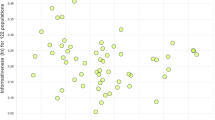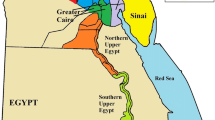Abstract
We have analyzed 105 autosomal polymorphic short tandem repeat (STR) loci for nine East and South-eastern Asian populations (two Japanese, five Han Chinese, Thai, and Burmese populations) and a Caucasian population using a multiplex PCR typing system. All the STR loci are genomewide tetranucleotide repeat markers of which the total number of observed alleles and the observed heterozygosity were 756 and 0.743, respectively, for Japanese populations. Phylogenetic analysis for these allele frequency data suggested that the Japanese populations are more closely related with southern Chinese populations than central and/or northern ones. STRUCTURE program analysis revealed the almost clearly divided and accountable population structure at K=2–6, that the two Japanese populations always formed one group separated from the other populations and never belong to different groups at K≥3. Furthermore, our new allele frequency data for 91 loci were analyzed with those for 52 worldwide populations published by previous studies. Phylogenetic and multidimensional scaling (MDS) analyses indicated that Asian populations with large population size (six Han Chinese, three Japanese, two Southeast Asia) formed one distinct cluster and are closer to each other than other ethnic minorities in east and Southeast Asia. This pattern may be the caviar of comparing populations with greatly differing population sizes when STR loci were analyzed.






Similar content being viewed by others
References
Aikens CM, Higuchi T (1982) Prehistory of Japan. Academic Press, New York
Ayub Q, Mansoor A, Ismail M, Khaliq S, Mohyuddin A, Hameed A, Mazhar K, Rehman S, Siddiqi S, Papaioannou M, Piazza A, Cavalli-Sforza LL, Mehdi SQ (2003) Reconstruction of human evolutionary tree using polymorphic autosomal microsatellites. Am J Phys Anthropol 122:259–268
Bannai M, Ohashi J, Harihara S, Takahashi Y, Juji T, Omoto K, Tokunaga K (2000) Analysis of HLA genes and haplotypes in Ainu (from Hokkaido, northern Japan) supports the premise that they descent from Upper Paleolithic populations of East Asia. Tissue Antigens 55:128–139
Bowcock AM, Ruiz-Linares A, Tomfohrde J, Minch E, Kidd JR, Cavalli-Sforza LL (1994) High resolution of human evolutionary trees with polymorphic microsatellites. Nature 368:455–457
Brinkmann B, Sajantila A, Goedde HW, Matsumoto H, Nishi K, Wiegand P (1996) Population genetic comparisons among eight populations using allele frequency and sequence data from three microsatellite loci. Eur J Hum Genet 4:175–182
Cavalli-Sforza LL, Edwards AWF (1967) Phylogenetic analysis: models and estimation procedures. Am J Hum Genet 19:233–257
Chakraborty R, Fornage M, Gueguen R, Boerwinkle E (1991) Population genetics of hypervariable loci: analysis of PCR based VNTR polymorphism within a population. In: Burke T, Dolf G, Jeffreys AJ, Wolff R (eds) DNA fingerprinting: approaches and applications. Birkhauser Verlag, Berlin, pp 127–143
Chu JY, Huang W, Kuang SQ, Wang JM, Xu JJ, Chu ZT, Yang ZQ, Lin KQ, Li P, Wu M, Geng ZC, Tan CC, Du RF, Jin L (1998) Genetic relationship of populations in China. Proc Natl Acad Sci USA 95:11763–11768
Edwards A, Hammond HA, Jin L, Caskey CT, Chakraborty R (1992) Genetic variation at five trimeric and tetrameric tandem repeat loci in four human population groups. Genomics 12:241–253
Felsenstein J (1995) Phylogeny Inference Package (PHYLIP).v.3.57c. Universuty of Washington, Seattle
Guo SW, Thompson EA (1992) Performing the exact test of Hardy-Weinberg proportion for multiple alleles. Biometrics 48(2):361–372
Hammer MF, Horai S (1995) Y chromosomal DNA variation and the peopling of Japan. Am J Hum Genet 56:951–962
Hanihara K (1991) Dual structure model for the formation of the Japanese. Jpn Rev 2:1–33
Hatta Y, Ohashi J, Imanishi T, Kamiyama H, Iha M, Simabukuro T, Ogawa A, Tanaka H, Akaza T, Gojobori T, Juji T, Tokunaga K (1999) HLA genes and haplotypes in Ryukyuans suggest recent gene flow to the Okinawa Islands. Hum Biol 71:353–365
Horai S, Murayama K, Hayasaka K, Matsubayashi S, Hattori Y, Fucharoen G, Harihara S, Park K-S, Omoto K, Pan I-H (1996) mtDNA polymorphism in Asian populations, with special reference to the peopling of Japan. Am J Hum Genet 59:579–590
Kumar S, Tamura K, Jakobsen IB, Nei M (2001) MEGA2: molecular evolutionary genetics analysis software. Bioinformatics 17:1244–1245
Lines M (1999) The Kalasha people of north-western Pakistan. Emjay books International, Peshawar
Latter BDH (1972) Selection in finite populations with multiple alleles III Genetic divergence with centripetal selection and mutation. Genetics 70:475–490
Mansoor A, Mazhar K, Khaliq S, Hameed A, Rehman S, Siddiqi S, Papaioannou M, Cavalli-Sforza LL, Mehdi SQ, Ayub Q (2004) Investigation of the Greek ancestry of populations from northern Pakistan. Hum Genet 114:484–490
Matsumoto H (1988) Characteristics of Mongoloid and neighboring populations based on the genetic markers of human immunoglobulins. Hum Genet 80:207–218
Mizutani M, Yamamoto T, Torii K, Kawase H, Yoshimoto T, Uchihi R, Tanaka M, Tamaki K, Katsumata Y (2001) Analysis of 168 short tandem repeat loci in the Japanese population, using a screening set for human genetic mapping. J Hum Genet 46(8):448–455
Nei M (1972) Genetic distance between populations. Amer Nat 106:283–291
Nei M, Tajima F, Tateno Y (1983) Accuracy of estimated phylogenetic trees from molecular data. J Mol Evol 19:153–170
Nei M (1995) The origins of human populations: genetic, linguistic, and archeological data. In: Brenner S, Hanihara K (eds) The origin and past of modern humans as viewed from DNA. World Scientific, Singapore, pp 71–91
Omoto K, Saitou N (1997) Genetic origins of the Japanese: a partial support for the dual structure hypothesis. Am J Phys Anthropol 102:437–446
Oota H, Saitou N, Matsushita T, Ueda S (1999) Molecular genetic analysis of remains of a 2,000-year-old human population in China-and Its relevance for the origin of the modern Japanese population. Am J Hum Genet 64:250–258
Oota H, Kitano T, Jin F, Yuasa I, Wang L, Ueda S, Saitou N, Stoneking M (2002) Extreme mtDNA Homogeneity in Continental Asian Populations. Am J Phys Anthropol 118:146–153
Pe´rez-Lezaun A, Calafell F, Mateu E, Comas D, Ruiz-Pacheco R, Betranpetit J (1997) Microsatellite variation and the differentiation of modern humans. Hum Genet 99:1–7
Pritchard JK, Stephens M, Donnelly P (2000) Inference of population structure using multilocus genotype data. Genetics 155:945–959
Qamar R, Ayub Q, Mohyuddin A, Helgason A, Mazhar K, Mansoor A, Zerjal T, Tyler-Smith C, Mehdi SQ (2002) Y chromosomal DNA variation in Pakistan. Am J Hum Genet 70:1107–1124
Reynolds J, Weir BS, Cockerham CC (1983) Estimation of the coancestry coefficient: basis for a short term genetic distance. Genetics 105:767–779
Rogers JS (1972) Measures of genetic similarity and genetic distance. In: Wheeler MR (ed) Studies in genetics VII. University of Texas, Austin, TX, pp 145–153
Rosenberg NA, Pritchard JK, Weber JL, Cann HW, Kidd KK, Zhivotovsky LA, Feldman MW (2002) Genetic structure of human populations. Science 298:2381–2385
Roubinet F, Despiau S, Calafell F, Jin F, Bertanpetit J, Saitou N, Blancher A (2004) Evolution of the O alleles of the human ABO blood group gene. Immunohematology 44:707–715
Saitou N, Nei M (1987) The neighbor-joining method: a new method for reconstructing phylogenetic trees. Mol Biol Evol 4:404–425
Saitou N, Omoto K, Du C, Du R (1994) Population genetic study in Hainan Island, China II Genetic affinity analyses. Anthropol Sci 102:129–147
Saitou N, Tokunaga K, Omoto K (1992) Genetic affinities of human populations. In: Roberts DL, Fujiki N, Torizuka K (eds) Society for the study of human biology symposium series 33: isolation and migration. Cambridge University Press, Cambridge, pp 118–129
Tajima A, Pan IH, Fucharoen G, Fucharoen S, Matsuo M, Tokunaga K, Juji T, Hayami M, Omoto K, Horai S (2002) Three major lineages of Asian Y chromosomes: implications for the peopling of east and southeast Asia. Hum Genet 110:80–88
Tajima A, Hayami M, Tokunaga K, Juji T, Matsuo M, Marzuki S, Omoto K, Horai S (2004) Genetic origins of the Ainu inferred from combined DNA analyses of maternal and paternal lineages. J Hum Genet 49:187–93
Takezaki N, Nei M (1996) Genetic distances and reconstruction of phylogenetic trees from microsatellite DNA. Genetics 144:389–399
Tanaka M, Takeyasu T, Fuku N, Li-Jun G, Kurata M (2004) Mitochondrial genome single nucleotide polymorphisms and their phenotypes in the Japanese. Ann NY Acad Sci 1011:7–20
Tokunaga K, Ohashi J, Bannai M, Juji T (2001) Genetic link between asians and native americans: evidence from HLA genes and haplotypes. Hum Immunol 62:1001–1008
Weir BS (1992) Independence of VNTR alleles defined as fixed bins. Genetics 130:873–887
Zhivotovsky LA, Rosenberg NA, Feldman MW (2003) Features of evolution and expansion of modern humans, inferred from genomewide microsatellite markers. Am J Hum Genet 72:1171–1186
Acknowledgements
We are grateful to Prof. Sirirurg Songsivilai, Dr. Hla Hla Htay, and Dr. Yuri E. Dubrova for providing Thais, Burmese, and Caucasian DNA samples, respectively. We also thank Dr. Naoko Takezaki for helpful technical assistance and comments. This work was in part supported by Grants-in-Aid for Scientific Research from the Ministry of Education, Culture, Sports, Science, and Technology of Japan (12012204 to TY and 11307008 to YK).
Author information
Authors and Affiliations
Corresponding author
Rights and permissions
About this article
Cite this article
Li, SL., Yamamoto, T., Yoshimoto, T. et al. Phylogenetic relationship of the populations within and around Japan using 105 short tandem repeat polymorphic loci. Hum Genet 118, 695–707 (2006). https://doi.org/10.1007/s00439-005-0106-9
Received:
Accepted:
Published:
Issue Date:
DOI: https://doi.org/10.1007/s00439-005-0106-9




